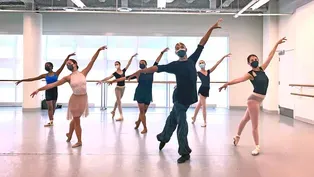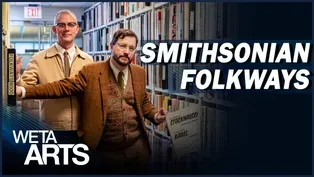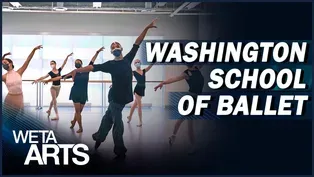
Behind the Scenes at the National Museum of the Army
Clip: Season 11 Episode 3 | 7m 57sVideo has Closed Captions
Felicia Curry talks with museum director Tammy Call.
In 2020, the Washington area welcomed a new museum that had been in the works for over 20 years. Located at Fort Belvoir, the National Museum of the United States Army is dedicated to showcasing an organization that predates the founding of our nation. WETA Arts host Felicia Curry met with Tammy Call, the museum's director, to learn more about the institution's history, mission, and vision.
Problems with Closed Captions? Closed Captioning Feedback
Problems with Closed Captions? Closed Captioning Feedback
WETA Arts is a local public television program presented by WETA

Behind the Scenes at the National Museum of the Army
Clip: Season 11 Episode 3 | 7m 57sVideo has Closed Captions
In 2020, the Washington area welcomed a new museum that had been in the works for over 20 years. Located at Fort Belvoir, the National Museum of the United States Army is dedicated to showcasing an organization that predates the founding of our nation. WETA Arts host Felicia Curry met with Tammy Call, the museum's director, to learn more about the institution's history, mission, and vision.
Problems with Closed Captions? Closed Captioning Feedback
How to Watch WETA Arts
WETA Arts is available to stream on pbs.org and the free PBS App, available on iPhone, Apple TV, Android TV, Android smartphones, Amazon Fire TV, Amazon Fire Tablet, Roku, Samsung Smart TV, and Vizio.
Providing Support for PBS.org
Learn Moreabout PBS online sponsorshipMan: 3, 2, 1.
Curry, voice-over: In 2020, the Washington area welcomed a new museum that had been in the works for over 20 years.
Located at Fort Belvoir, the National Museum of the United States Army is dedicated to showcasing an organization that predates the founding of our nation.
I met with Tammy Call, the museum's director, to learn more about the institution's history, mission, and vision.
We're here at Fort Belvoir.
Why was this the location that was decided on for this massive project?
The Army conducted several site studies to find just that perfect location.
We are just south of D.C. We are just right off of I-95, so we're very easy to get to.
We do formally sit on Fort Belvoir-- that's our address-- but we are fully publicly accessible just directly off of Fairfax County Parkway.
♪ Tell me a little bit about how this museum came to be.
I know it's been in the works since about 2000.
The museum facility was constructed using private donor dollars that was managed by the Army Historical Foundation.
The project itself had about 35 different stakeholder groups involved as we went into construction.
Can you tell us a little bit about the exterior?
It's stunning.
The stainless steel represents the strength of the Army, and it's also reflective in nature, and so as our daily environmental conditions change, so too does the exterior of the museum, and this is really a nod to the fact that the Army is a ground force, and so every day when clouds roll in or the sun breaks free, it's reflecting what our soldiers see and what they experience on a daily basis.
♪ Through the individual soldier stories, you can see with the pylons, they begin outside.
They march through the lobby and into formation.
♪ What's on the ceiling here?
For every campaign that the Army has fought in, there's a campaign streamer, starting with the Revolutionary War and then all of the major battles of that war.
[Fife and drums playing] ♪ Tell me about some of your favorite places here in the museum.
I get asked often what's my favorite artifact.
We have 3 service jackets from 3 brothers-- the Myers brothers.
They each served in a different division in World War I, and it's just an incredible story because, one, they all came home, and then a daughter of one of the brothers, she actually visited the museum just as we opened.
She didn't know that we had their coats on display.
We've got those stories just scattered everywhere in this museum.
It's not just a museum of artifacts.
It really is a museum of stories.
We are telling the comprehensive history of the Army through personal soldier stories.
You're going to see the items that they used-- their helmets, their weapons, a pocket Bible, and then there's some of those very iconic, big, large, macro artifacts.
♪ This is an actual landing craft.
In fact, it's one of 6 that's still in existence.
It carried World War II soldiers to the beaches of Normandy.
[Explosions] ♪ We brought the scene to life using our cast figures, which were cast using currently serving soldiers.
When you look at their faces, I mean, the detail, even in their eyes and the way they're holding their arms and their hands, it's so super specific.
These cast figures are a way to draw the visitor in, helping our American citizens understand not only the Army as an organization, but our American soldiers.
[Buffalo Springfield's "For What It's Worth" playing] We are at a display in the Vietnam Gallery within the Cold War Gallery.
We're at a map of Vietnam, and you can see where all of the Army corps were located at in Vietnam, and this map specifically allows our Vietnam veterans to talk about where they landed, right?
Did they fly into Vietnam?
Did they come by ship?
Stephen Stills: ♪ There's something happening here ♪ ♪ But what it is ain't exactly clear... ♪ Call: Vietnam veterans who may not know each other start to swap stories, and they start talking about their own experiences, and I hear things like, "Dad, you never told us that," or, "Mom, I didn't know that you were there as a nurse."
This map allows the veterans to start talking to their family and new friends about their own experience in Vietnam.
Tell us a little bit about what some veterans who have visited here have said to you about their experience here.
Our veterans are just thrilled after they've gone through the museum.
They feel like they've come home, and that was one of our missions, for our veterans to come and visit and see themselves reflected here, see their time of service here, and be able to really walk away with such a sense of contribution.
Why was it important that the museum have a piece that's interactive?
There are so many different roles available within the Army, and we want people to understand that.
We have simulators.
You can be a doctor.
You can be an engineer, a pilot, you know, just so many roles that are available to our citizens and if they choose to serve their country.
Oh, so this is the hands-on learning part.
Call: Get it--yeah.
Um, OK. Now that.
Where is it?
Oh, right there.
This drives across.
[Laughs] Yes!
Ha ha ha!
Good job.
Good job.
You could be an engineer.
That is a good feeling.
All right.
Ha ha!
And you have a personal story with the Army itself.
I grew up in the Army, and then I'm a veteran.
Coming to lead the project through construction, through opening, and now for daily operations, it is the greatest honor of not only my career, but my life.
I'm very humbled by it, and I'm so proud of the staff that are here, of our volunteers, and of the visitors and what we hear from them.
♪ What do you hope people take away from a visit here at the museum?
I hope that they take away with them the spirit of the American soldier.
It's America's army.
It's our citizens' army, and so I hope they walk away from here taking great pride in how it's defended this nation for coming up on 250 years.
Tammy, thank you so much for joining us on "WETA Arts."
It's been a pleasure to meet you, to spend this time with you, and to spend time here in this incredible museum.
Thank you.
It's been lovely sharing the museum with you.
The National Museum of the United States Army is at Fort Belvoir near the I-95 exit toward Newington and right off Fairfax County Parkway.
There are family activities on weekends, monthly veterans clinics, and online presentations about Army history.
For more information about upcoming programs, go to thenmusa.org/events.
Preview: WETA Arts November 2023
Preview: S11 Ep3 | 30s | Smithsonian Folkways; Washington School of Ballet; National Museum of the U.S. Army (30s)
Smithsonian Folkways Celebrates Its 75th Anniversary
Video has Closed Captions
Clip: S11 Ep3 | 9m 44s | Smithsonian Folkways celebrates their anniversary with a creative project. (9m 44s)
Washington School of Ballet Adult Program
Video has Closed Captions
Clip: S11 Ep3 | 8m 42s | The Washington School of Ballet offers open classes for adults at all skill levels. (8m 42s)
Providing Support for PBS.org
Learn Moreabout PBS online sponsorshipSupport for PBS provided by:
WETA Arts is a local public television program presented by WETA














